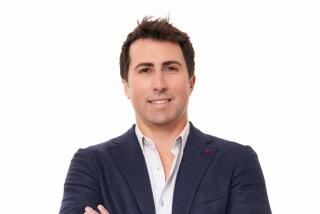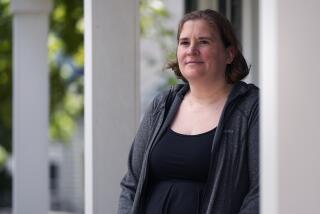In Neighborhoods Overlooked by Banks, Check-Cashing Stores Flourish : Money: They charge high prices but offer services often unavailable to the poor. Congress debates fee caps.
- Share via
NEW YORK — The handwritten signs at Check Express, a check-cashing store near Manhattan’s Grand Central Terminal, offered busy passersby an assortment of financial products.
There were Western Union money transfers, money orders, electronic tax refunds, private postal boxes, subway tokens, even a place to pay the phone bill.
Although many of the services came at a premium price, the outlet attracted a steady stream of customers even at off-peak hours.
“Banks don’t offer as many services,” said Noel Anderson, 38, as he entered the simple storefront. “You get your money. You pay your bills. You get your tokens . . . What’s an extra dollar here and there?”
For more and more Americans, this is banking in the ‘90s.
With about 5,000 outlets nationwide--nearly double in number from five years ago--the check-cashing industry is one of the fastest growing financial services today. Check cashers cash more than 150 million checks a year, with a face value of more than $45 billion, the industry estimates. In 1990 alone, check-cashing outlets took in about $790 million in fees.
As their popularity has increased, these outlets have expanded from mom-and-pop operations with roots from the Great Depression into major businesses. Western Union Financial Services Inc., for instance, got into the check-cashing business two years ago, and even some banks have gotten into the act. First National Bank of Chicago announced last spring that it was offering limited check-cashing services for non-customers.
The explosive growth comes partly in response to the banking industry’s consolidation. While many bank and savings and loans shut down unprofitable branches over the past decade, particularly in poor urban neighborhoods, check-cashing outlets filled the void.
In many inner-city areas the ratio between outlets and bank branches is overwhelming. In Central Los Angeles, for example, it’s around 7-to-1; on Chicago’s west side, it’s 9-to-1.
In Brooklyn’s Bedford-Stuyvesant neighborhood, there are 27,200 people per bank branch, more than five times the national average of 5,000 per branch.
More recently, though, check-cashing outlets have begun making inroads into more affluent areas, appealing to people like Anderson, the Check Express customer, who already have a bank account but like the outlets’ flexible hours and wide range of services.
Many check-cashing outlets remain open around the clock and offer everything from postage stamps and lottery tickets to motor vehicle registration and welfare benefit claims, in addition to check cashing.
“We’re like the 7-Eleven of the financial services industry in terms of convenience,” said Howard Mandelbaum, executive director of the National Check Cashers Assn., a trade group based in Paramus, N.J. “Of course, you pay for that convenience.”
That’s fine for those who can afford it, consumer groups argue, but in many areas the high-priced check-cashing outlets offer the only means for low- to moderate-income families to cash checks and pay bills.
About 17% of all U.S. families don’t have bank accounts. Many live from paycheck to paycheck, unable to open an account because they can’t meet minimum balance requirements or can’t find a bank branch nearby.
So they turn to what John P. Caskey, an economics professor for Swarthmore College in Swarthmore, Pa., has dubbed the “fringe banking system,” which includes pawn shops as well as check-cashing outlets. Both charge high fees yet neither establishes the kind of community stability needed to draw new businesses or help residents prosper.
“The rise of fringe banking . . . signals an increasing fragmentation of the financial system,” Caskey said.
He attributed this change to the decline in the standard of living of low-income households and changes in bank regulations during the ‘80s.
“It’s one of these examples as to why it’s expensive to be poor,” said Debby Goldberg, a neighborhood reinvestment specialist for the Center for Community Change, a Washington lobby group. “It’s very ironic and it’s really unfair, but it’s a fact of life for many people.”
Check-cashing outlets charge anywhere from 1% to 20% of a check’s face value -- with the average somewhere between 2% and 3% -- depending on the type of check cashed and where the outlet is located.
The outlets are largely unregulated. Only 11 states place a ceiling on check-cashing fees or have licensing requirements. New York, for instance, has a 1.1% cap on all checks.
Congress, though, is debating legislation that would set a maximum checking-cashing fee for all outlets and require licensing by the Federal Trade Commission. It also would require all financial institutions to cash government checks.
“There’s no question the only thing that will lower fees is government regulation,” said Stephen Brobeck, executive director of the Consumer Federation of America in Washington, which provided supporting testimony before a recent subcommittee hearing.
“There’s no reason to charge what they do for cashing government checks,” Brobeck said. “The risk of a government or pay check failing to clear is very small.”
But the check-cashing industry says it’s not to blame. Like any business, it has expenses to cover, including the risk of check bouncing or fraud. In addition, there’s growing competition with other places that cash checks, like supermarkets and liquor stores as well as banks.
“Banks also charge for their services, explicitly and implicitly. We’re competing for a piece of the business,” said NCCA’s Mandelbaum.
While that’s true, studies show it’s still much cheaper to maintain a bank account than to do business at a check-cashing outlet.
One study conducted by Caskey, of Swathmore College, found that a family of four with $24,000 annual income would spend $396 a year to cash paychecks or government entitlement checks at an outlet charging a 1.5% fee and to buy six money orders a month at 50 cents apiece.
That same family could have a free bank checking account if they maintained a minimum balance averaging $480, says a 1990 study by the Consumer Federation of America. The CFA said that as long as they didn’t bounce too many checks or fall too often below minimum balance requirements, they’d still be ahead of the game. Monthly maintenance fees range from $5 to $10 and fees for bounced checks from $15 to $25.
“Clearly if you use the bank services, it’s going to be cheaper,” said Fritz Elmendorf, spokesman for the Consumer Bankers Assn. in Arlington, Va.
The bankers association recently surveyed 147 large banks and S&Ls; and found nearly 95% provided some type of basic account with low fees and limited free checking. Most had no minimum balance requirements.
While acknowledging that many banks have closed unprofitable branches, Elmendorf said the data showed the industry was working to meet the needs of low- to moderate income families.
“Some people just feel more comfortable using a check-cashing store,” he said. “Plus, frankly, some of this . . . check-cashing business probably represents the underground economy or people wanting to avoid any type of official records for tax purposes or immigration status.”
More to Read
Inside the business of entertainment
The Wide Shot brings you news, analysis and insights on everything from streaming wars to production — and what it all means for the future.
You may occasionally receive promotional content from the Los Angeles Times.










